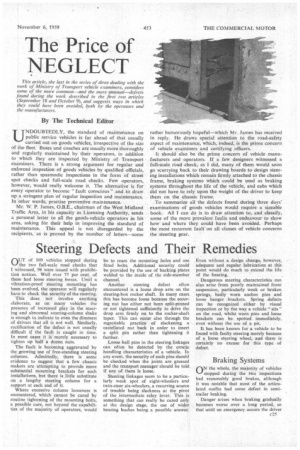The Price of NEGLECT
Page 63

If you've noticed an error in this article please click here to report it so we can fix it.
This article, the last in the series of three dealing with the work of Ministry of Transport vehicle examiners, considers some of the more common—and the more unusual—defects found during the work described in the first two articles (September 18 and October 9), and suggests ways in which they could have been avoided, both by the operators and the manufacturers.
By The Technical Editor
UNDOUBTEDLY, the standard of maintenance on public service vehicles is far ahead of that usually carried out on goods vehicles, irrespective of the size of the fleet. Buses and coaches are usually more thoroughly and regularly maintained by their operators, in addition to which they are inspected by Ministry of Transport examiners. There is a strong argument for regular and enforced inspection of goods vehicles by qualified officials, rather than spasmodic inspections in the form of street spot checks and full-scale road checks. Few operators, however, would really welcome it. The alternative is for every operator to become "fault conscious" and to draw up a stringent plan of regular inspection and maintenance. In other words, practise preventive maintenance.
Mr. W. P. James, 0.B.E., chairman of the West Midland Traffic Area, in his capacity as Licensing Authority, sends a personal letter to all the goods-vehicle operators in his area, asking for their help in improving the standard of maintenance. This appeal is not disregarded by the recipients, as is proved by the number of letters—some rather humorously hopeful—which Mr. James has received in reply. He draws special attention to the road-safety aspect of maintenance, which, indeed, is the prime concern of vehicle examiners and certifying officers.
It shouldalso be the prime concern of vehicle manufacturers and operators. If a few designers witnessed a full-scale road check, as I did, many of them would soon go scurrying back to their drawing boards to design steering installations which remain firmly attached to the chassis frame, braking systems which could be used as braking systems throughout the ,life of the vehicle, and cabs which did not have to rely upon the weight of the driver to keep them on the chassis frame.
To summarize all the defects found during three days' examinations of goods vehicles would require a sizeable book. All I can do is to draw attention to, and classify, some of the more prevalent faults and endeavour to show how and where they could have been avoided. Perhaps the most recurrent fault on all classes of vehicle concerns the steering gear.












































































































